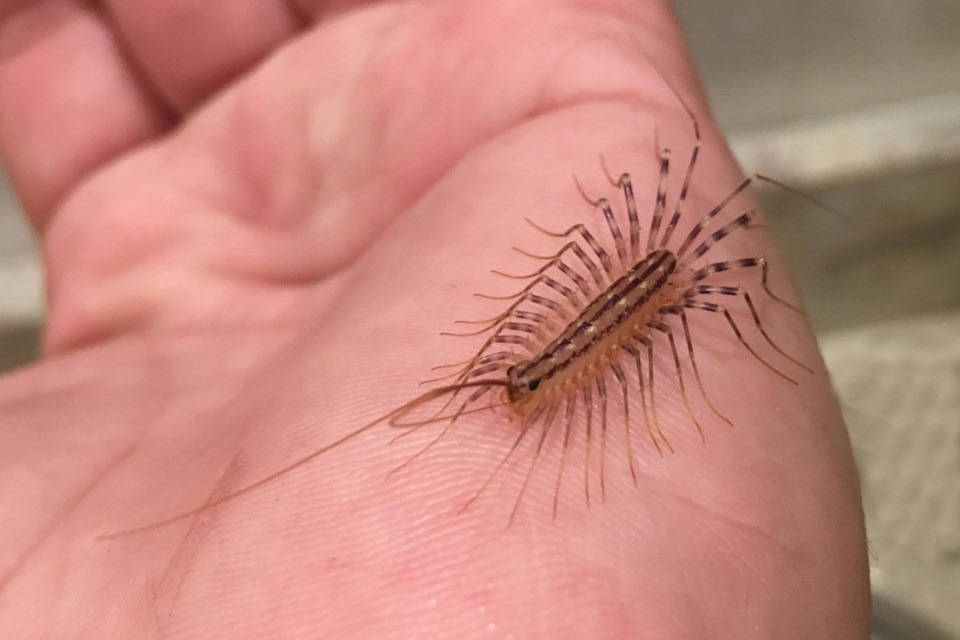What has 30 rather long legs, runs like greased lightning, is only a couple inches long at best, eats living prey, has venom in its mouth, is able to climb walls, shuns the light, and lives in your house? A character from a Stephen King horror novel? Nope, guess again.
How many of you guessed "scutigera"? Oh yeah, now that I told you the answer, you're all nodding your heads. Just like high school, eh, "Yeah, that's what I was going to say, scuttle…scootle… whatever it was."
Okay, the more easily remembered name is House Centipede. Sound more familiar? Well, it shouldn't, as these little guys are few and far between, at least around here. However, down south (way down south) they are indeed quite common.
My wife, Julie, and I have been called upon to identify this fascinating yet creepy creature about three times a year. They have been captured in Anten Mills and Orillia, and two were cornered and crated in Coldwater. Oh, there's lots more of them out there, but these ones had slow reflexes and were 'collected'.
When a hair-raising, gut-wrenching, stomach-flipping, weird looking creature is properly collected, it means that rather than being flattened with a weekend newspaper dropped on it from waist height, it is scooped up in a container, placed in the freezer, and later brought in for identification.
Unfortunately, a specimen brought in for analysis that has been collected via the mulched tree dropped on their head technique aren't easy to identify. "Oh look dear, a leg, I think. What do you suppose it belonged to?"
As it's been, all specimens collected for us have been in quite good shape (other than being dead, of course).
House centipedes, while being quite voracious and lively, are not a threat to humans, nor are they a sign that you are living in squalor. No need to fumigate, no need to sell the house at an amazingly low price, no need to lie awake at night, listening… listening… listening.
A really big house centipede is as long as your little finger. See, not so bad, unless you have abnormally large hands. What makes them appear so large is the length of their legs in comparison to their body size. Remember, they have 30 legs, a pair for each body segment, and these legs are long and nimble.
When prey is sighted, or you suddenly turn the room light on (and yell "surprise"), they rise up on their tip-toes, hunch like a sprinter on the starting blocks, and… varoom, they're off! Their speed makes them appear to float or fly, except for the sight of all those legs working in an undulating synchronized fashion.
Like synchronized swimming, with all those legs waving about in an unreal manner, just looking at it can give you the willies; there's that wee small voice in your head screaming, "That's just not right." But I digress.
House centipedes need to move fast as they are hunters and they run down their prey. Silverfish, flies and other common household pests (they are common, right? Just like our place, right?) are consumed while still writhing from a venomous bite.
So house centipedes are, like, your friends, you know? They keep out of your way, they clean up other bothersome house guests, and don't overpopulate their living areas. In the summertime, they even move outdoors, kind of like going to the cottage (there's always way more bugs at the cottage).
The best hypothesis as how or why these critters are arriving in our neighbourhood is the transportation of furniture. Whether in a warehouse or a real house, somewhere south of the border, these guys slip into the dark corners of the underside of a sofa, are loaded on a truck and are then inadvertently delivered into Ontario. Two of the cases we worked on involved recent furniture additions to the home.
If you'd like to find out more about these eerie, mini-dustmop-looking things, check out an Internet search for "scutigera", and brace yourselves for a visual shock. "That thing's living in my house?! Un-ah, no sir, not with me it ain't." So hey, if you knock $100,000 off for a quick sale, I might be interested.
